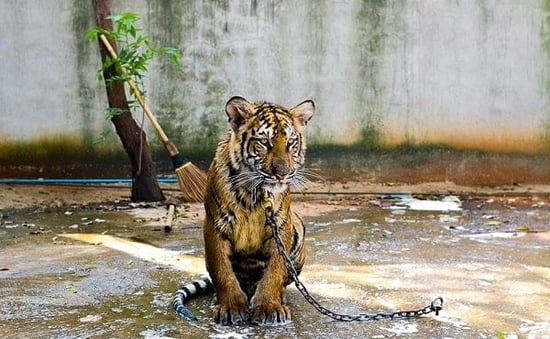
What you didn’t learn from Tiger King on Netflix
News
Tiger King is a popular Netflix show right now. But with a focus on murder and mayhem, there are some major animal welfare issues that get glossed over in the series.
Tigers are not photo props
One thing we can all agree on is that tigers are beautiful animals and tremendously cute as cubs. In Tiger King, we watched Joe Exotic use a number of tiger cubs, providing an up close experience for paying visitors while a photographer followed, snapping souvenir photos.
What many people might not realise is the cruel industry behind cub petting and “meet-and-greets” like those held by Joe Exotic.
While tigers in the wild will stay with their mother for up to two years, for this industry, tigers are taken away from their mothers immediately after birth. After removal, the cubs are bottle fed and intensively exposed to humans. But once the cubs grow up and become too large and dangerous for petting and photo sessions, they are replaced with a new cub. This is a horrific never-ending cycle for the sole purpose of keeping the tourist activities going. The industry of cub petting is responsible for a surplus of tigers (and other wild animals) in captivity, as well as intensive breeding practices.
Furthermore, the exposure to humans and unnatural settings can be immensely stressful for the little tiger cubs.
Tigers belong in the wild
Tigers are magnificent animals who roam the grasslands and jungles of eastern Asia.
They are solitary territorial animals and can have home ranges of almost 300km² [1]. Weighing at times over 300kg and with a length of approximately 3 meters, tigers are the largest member of the cat family. They are incredibly agile and fast, and can jump more than 10 meters. Unlike other cats, they love water and are good swimmers.
Despite what you may have heard in Tiger King, these big cats are not able to adapt within their lifetimes to cope with an existence in a cage in Florida (or anywhere). In captivity, a tiger’s natural behaviours and movements are extremely restricted, causing stress, boredom, and frustration.
Tigers are evolved to survive in the wild; they are not domesticated and do not belong in captivity.
Tigers suffer immensely in captivity
Tigers often show locomotory stereotypical behaviours, such as pacing, when kept in captivity, which is a strong indication that the animal is experiencing stress. It is thought that pacing behaviour in animals is associated with their natural home range size: the larger the animal’s home range, the higher the chance they will develop this abnormal behaviour [2]. Throughout Tiger King, we see Joe Exotic’s tigers pacing in their cells, panting, walking back and forth in the same tiny space. It’s a heartbreaking reality of keeping these intelligent, magnificent animals locked up for human entertainment.
Another common sight in captivity is tigers in poor physical condition, either being overweight due to an improper diet and a lack of exercise, or underweight due to stress, illness or having to compete for food. Many of the tigers in Tiger King appeared to have a poor body condition, which might not be surprising since it was admitted in the show that it was challenging to provide a wholesome diet for the animals. Also, since tigers are solitary animals, they are not accustomed to competing with other tigers for food.
Tigers pose major health risks to humans who keep them
Tigers are one of the most dangerous animals to care for and zoological societies across the world have strict guidelines on how to take care of tigers in captivity. For example, America’s Association of Zoos & Aquariums writes in their 2016 tiger manual: “Tigers are large, dangerous animals that can easily cause injury or death to other animals or humans, and great care should be used when in their proximity.
All staff working with tigers should receive thorough training...” It is not uncommon that tigers inflict injury on their keepers, as we saw in episode two of Tiger King, when tiger keeper Saff’s arm is mauled.
Sources
[1] Simcharoen, A., Savini, T., Gale, G. A., Simcharoen, S., Duangchantrasiri, S., Pakpien, S., & Smith, J. L. (2014). Female tiger Panthera tigris home range size and prey abundance: important metrics for management. Oryx, 48(3), 370-377.
[2] Clubb, R., & Mason, G. J. (2007). Natural behavioural biology as a risk factor in carnivore welfare: How analysing species differences could help zoos improve enclosures. Applied Animal Behaviour Science, 102(3-4), 303-328.
In captivity, a tiger’s natural behaviours and movements are extremely restricted, causing stress, boredom, and frustration.
Animals, not entertainers
Across the globe, animals at wildlife tourism venues are forced to endure intense pain and mostly unseen suffering to entertain tourists and visitors on a daily basis.
Our wildlife work
Around the world, wild animals are being exploited. They’re hunted down, trapped and farmed in captivity, all to be sold and abused for entertainment, medicine, fashion, pets and products.





